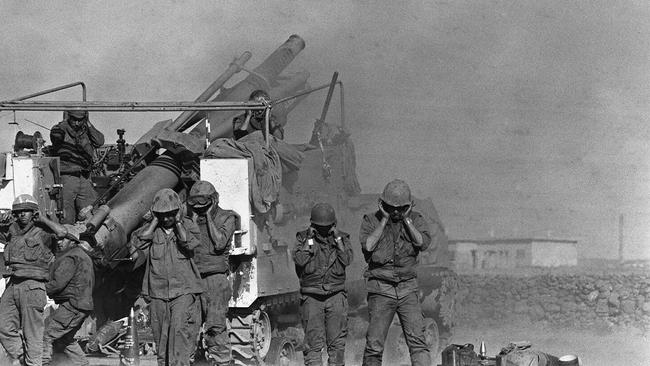Shifting sands of Arab alliances tells a tale of two Israels

The episode remains a national trauma. The series depicts the efforts of a small number of Israeli soldiers in the Golan Heights in the first days of the war, as they battle to stop the advance of the Syrian army towards the first Israeli civilian communities at the foot of the Heights.
Valley of Tears, among other things, presents an opportunity to observe the stark contrast between Israel’s difficult strategic situation nearly 50 years ago, and its position now. Then, the Jewish state faced a united wall of rejection from the Arabic-speaking states. By contrast, it maintained working diplomatic relations with the two non-Arabic-speaking countries of the Middle East — Iran and Turkey.
Then, there was near parity in conventional military capacities between Israel and its Arab neighbours. The result was that armed contests between the sides took the form of mass mobilisation of the army and the society, with broad sections of the population drawn into the war effort and large numbers of casualties.
Nearly half a century on, all this has been transformed. In recent months, obscured somewhat by the global focus on COVID-19, a number of dramatic events have taken place that have cast Israel’s changed (and improved) strategic situation into bold relief.
First, the US-brokered normalisation agreements with four Arab states demolish the notion of anything so simple as an “Arab-Israeli conflict” remaining in existence. The breakthrough with the United Arab Emirates brings the most developed Arab economy (and a former bastion of the Arab boycott and the Arab oil weapon against Israel) into effective alliance with Jerusalem.
De facto relations between Jerusalem and Abu Dhabi, and the close parity of analysis between the two countries regarding the main threats in the region, have long been one of the Middle East’s worst-kept secrets.
Both countries see Iran and its allies, and Sunni political Islam as represented by the Muslim Brotherhood and the government of Turkey, as central challenges. But the placing of relations on a formal footing is already producing a wave of private sector contacts, with major partnerships set to emerge. An Emirati company, Dubai-based DP World, for example, has submitted a bid to take part in the privatisation of the strategically important Haifa port, in Israel’s north. The possibilities are immense.
Bahrain, Sudan and Morocco are similarly launched on the path of normalisation with Israel.
Indeed, with Syria and Iraq broken and divided, Saudi Arabia engaged in behind-the-scenes co-operation, and Jordan and Egypt long at peace with Israel, there is today no powerful Arab state still engaged in the fight.
However, enemies remain. And it is interesting to note today it is the two other non-Arab states in the region — Iran and Turkey — that form the most powerful opponents of Jerusalem. The same states who, back in 1973, were semi-allies.
Iran remains the most serious challenge. But the ways of conflict today are very different. Israel has been engaged in a type of war with Iran for a number of years. But it is nothing like the massed, armoured set pieces on the Golan in 1973. It is a largely silent conflict fought far from visible channels, involving only a small number of Israeli agencies and citizens: namely, the intelligence services, parts of the air force and graduates of Israel’s most select special forces units.
In this “campaign between the wars”, Israel seeks to disrupt and reverse Iranian attempts to advance towards a nuclear capacity, and stymie Tehran’s effort to build infrastructure across the collapsed spaces of the Arab world (Syria, Iraq, Lebanon). The killing of nuclear scientist Mohsen Fakhrizadeh east of Tehran on November 27 may well have been an episode in this conflict. The weekly sorties by Israeli aircraft to target Iranian facilities in Syria form an additional element of the ongoing effort.
So from the vantage point of 2020, the embattled Israel of 1973, facing the combined might of powerful, centralised neighbouring Arab states, seems distant. There is, nevertheless, an important lesson still to be learned from that time. The Yom Kippur War was a black swan event, unexpected, erupting in a period in which Israel’s situation, to quote one leader of that time, “had never been better”.
The Middle East remains a dynamic and fluid arena in which today’s enemy can be tomorrow’s friend, and vice versa, and in which things can change, for better or worse, completely, and fast.
Jonathan Spyer is director of the Middle East Centre for Reporting and Analysis.



A drama series recently broadcast on national TV in Israel, entitled (in English) Valley of Tears and set in the dramatic first days of the Yom Kippur War of 1973, has led to renewed public discussion of those difficult days. On October 6, 1973, Israel was caught by surprise when the full force of two Arab armies — Egypt from the south and Syria from the north — was launched at the Jewish state. Israel eventually prevailed, but at the very high cost of 2521 dead.